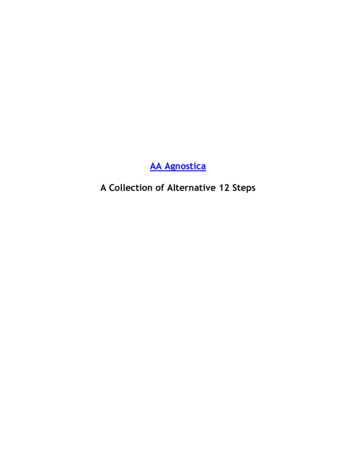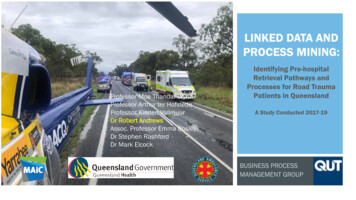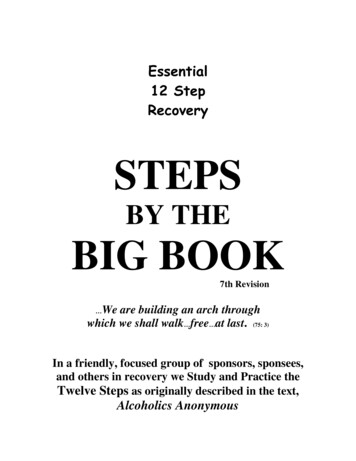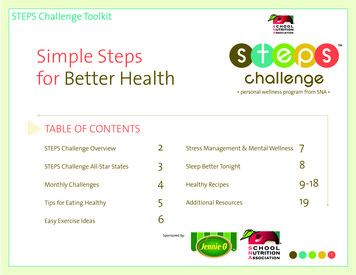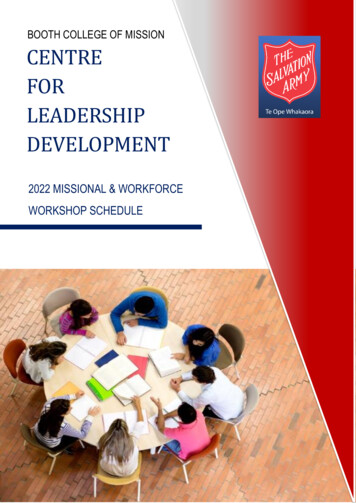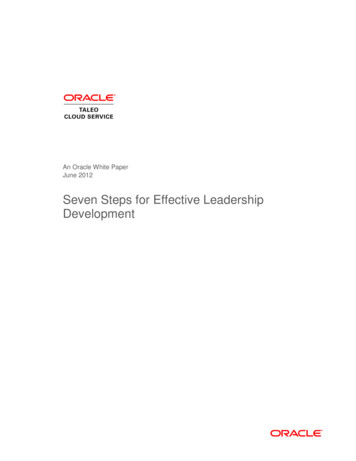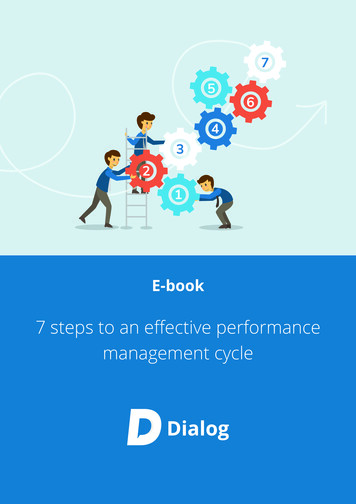
Transcription
7564321E-book7 steps to an effective performancemanagement cycle
Transforming Performance ManagementIntroductionThe goal of the performance management cycle is to support employees withlearning, development and performance. This results in a meaningful contributionto the success of their organization.Therefore, when transforming your performance management cycle, it is essentialto take the employee as your starting point. With that said: design your new performance management cycle with your employees, not for your employees.The seven steps that we present in this e-book will help create a cycle that trulysupports your employees in their learning, development and performance. If youneed any help, don’t hesitate to contact me.I wish you all the best with transforming your performance management cycle!Kind regards,Stefan Op de WoerdFounder Dialogstefan.opdewoerd@dialog.nl 31 6 24674286Dialog - 7 steps to an effective performance management cyclePage 2
Transforming Performance ManagementThe 7 steps for an effectiveperformance management cycle1Identifying problems of the current cycle2Establish starting points for the new cycle3Design the new cycle together with employees4Select supporting technology5Start experimenting with a few departments6Evaluate and learn7Include the organization in the new way of workingDialog - 7 steps to an effective performance management cyclePage 3
Transforming Performance Management1. Identifying problems of the current cycleTransforming just because you want something new is rarely a good idea. There isonly a valid reason to do something if the current situation does not suffice. Therefore, start by identifying the problems of the current cycle.Methods that will help you do this are: employee survey in-depth interviews with colleagues organizing interactive workshopsThe most important topics to be covered are: oals: Are the goals clear, challenging and achievable? Do you have insight inGthe progress? Are you adequately supported in achieving your goals? ersonal development: Do you think this is important? Do you have clearP development goals? Are you working on your personal development in yourdaily work? Are you sufficiently supported in your personal development? onversations: Do you have conversations about goals and personal developCment? How do you experience these? Are the conversations prepared enough? erformance review: Do you find the performance appraisals valuable? DoPyou experience this proces as fair? Does it encourage you to learn and perform?ResultYour employees feel heard and the problems they encounter are takenseriously.Dialog - 7 steps to an effective performance management cyclePage 4
Transforming Performance Management2. Establish starting points for the new cycleAs an organization, you probably have a vision of the way in which you can work together as an organization. This is a good starting point to give direction to the newperformance management cycle.A number of topics are valuable to think about:Ownership Are employees mainly in the lead themselves or does the manager give a lot of direction? Do you have or do you want self-managing teams? What role do you see for the manager?Transparency Are the organizational objectives transparent to all colleagues? And the progress onthese targets? Are the goals of individual employees transparent to all colleagues? Or does an employee decide for himself? Or is this agreed upon per team?Performance appraisals Do you think performance appraisals should play a role? Or do you want to stopdoing them? Who plays a role in the appraisal? Think of the employee himself, the manager, colleagues and customers. Who gives the final verdict: the employee himself, the manager, the team? How often does the appraisal take place? Is there a reward linked to the appraisal?Dialog - 7 steps to an effective performance management cyclePage 5
Transforming Performance ManagementFeedback How much do you value feedback as an organization? Is it mandatory for employees to ask for feedback? Is feedback purely focused on personal development or does it also play a rolein performance appraisal?Personal development Do you expect all employees to be actively involved in personal development?Or is this a choice? Do you want to use competencies to describe the expected behavior of employees? Is personal development part of the performance appraisal?Conversations How do you want employees to converse about their performance and development? Do they decide for themselves if and with whom they have these conversations? Are there fixed moments for these conversations throughout the year? Does anything need to be documented about the conversations?ResultYou have a vision on your performance management cycle. You cannow make design choices based on this.Dialog - 7 steps to an effective performance management cyclePage 6
Transforming Performance Management3. Design the new cycle together with employeesBecause the performance management cycle is intended to support employeesin learning, development and performance, you want to design the cycle togetherwith your employees.To achieve this, organizations often form a focus group that represents the organization. In a number of sessions, you will get a clear picture of what an effective cycle looks like.Start by sharing, testing and sharpening the vision. Then take steps to design a newcycle together. You define the subjects ownership, transparency, appraisals, feedback, personal development and conversations. You think about what is mandatory and what is optional, what is the minimum that needs to be documented, andwhich are the fixed moments for conversations.You can consider designing different variations of the cycle, which you are goingto test. Sometimes there are several good options and you don’t know in advance which ones will work best for your employees. Besides, distinct departmentscan significantly differ in the nature of their work, or the maturity of their teams. Therefore, a different cycle may be necessary.Resultyou have a way of working that you can test.Dialog - 7 steps to an effective performance management cyclePage 7
Transforming Performance Management4. Select supporting technologyA performance management cycle without any supporting technology is almostunthinkable nowadays. Good tech will smoothen the process: it gives insights andsupport at the right moments.Three elements are crucial for introducing supporting technology:1. T he technology shouldn’t determine what the cycle should do, the cycle shoulddetermine what the technology should do. So always pick your software basedon your predetermined requirements.2. T he technology should be flexible and adjustable, so that the changes that willundoubtedly come in the cycle, can also be made in the technology.3. T he technology should be extremely user-friendly. Employees must be happy touse it. Software that doesn’t work well for employees is a guarantee for a failedperformance management cycle.You can choose to introduce technology in a later stadium of the implementationof your new cycle. However, it’s important to realise that the technology can reallymake or break the success of your new cycle.ResultYou selected technology that perfectly fits your performance management cycle and makes it surprisingly easy for your employees.Dialog - 7 steps to an effective performance management cyclePage 8
Transforming Performance Management5. Start experimenting with a few departmentsDon’t try to perfect everything. Chances are that not everything you come up withwill work out in real life. This results in a lot of wasted time and energy. The bestway to quickly learn if your new cycle works is to start with experimenting.The key element of a successful experiment is learning as much as possible in aslittle time as possible. The best way to do this is to make hypotheses in a dvanceabout what you want to learn. You can then shape your experiments in a very specific way in order to validate (or falsify, of course) these hypotheses.A couple of examples of hypotheses you can test:Employees think about their goals more oftenEmployees are more aware of their personal development Employees have a clear understanding of how they contribute to the objectives of the organization or team Employees and managers have better insight into the progress made on thegoals The conversations of managers and employees are more often about goalsand personal development. Managers are better equipped to coach employees in learning and performingDialog - 7 steps to an effective performance management cyclePage 9
Transforming Performance Management Employees give each other feedback more often Reviewing performance feels easy and fairDo not hesitate to run several experiments in parallel. You can test different methods in different teams or the same method in teams that are very different inthe nature of their work. Make sure that you have a good view on your organization.ResultYou know what your key success factors are for the new performancemanagement cycle, and how you will test your new cycle.Dialog - 7 steps to an effective performance management cyclePage 10
Transforming Performance Management6. Evaluate and learnIt is now time to validate your hypotheses through experiments. Once you decidewhich teams will partake in the experiment, it is important to inform the teams ofwhat is going to happen and what you expect of them. Share with the team theproblems of the old way of working, as well as the vision on the new way of workingand the role they have in the experiment (for example giving feedback on the newway of working and possible improvements).It is also important to put a number of evaluation moments on the agenda. Duringthose moments you reflect on the hypotheses and adjust them if necessary basedon what you have learned so far.In this step you can use the same instruments as in step 1: a survey in-interviews workshopsIt is smart to start by measuring the baseline. This way you know exactly how theemployees are doing prior to the experiment, and you can measure the changesassociated with the new way of working.Our experience shows that three months is enough to complete the phase of experimentation. It is important that you run through all the elements of the performance management cycle in these three months. For example, do you havea performance appraisal at the end of the year? Then make sure you conclude your‘mini cycle’ of three months with a performance appraisal as well.Dialog - 7 steps to an effective performance management cyclePage 11
Transforming Performance ManagementImportant moments to evaluate in the experimental phase are: After setting the targets for performance and development (for example 2weeks after take-off) After the first period in which you reflect daily on your goals and development(for example 6 weeks after take-off) After a second period working with the new method. This is especially important if you adjusted the experiment after the first evaluation (for example10 weeks after take-off) After the first formal evaluation moment (usually immediately after the end ofthe three months)ResultThe new way of working is tested and sharpened. You now know that thenew performance management cycle is going to succeed!Dialog - 7 steps to an effective performance management cyclePage 12
Transforming Performance Management7. Include the organization in the new way of workingNow that you’ve discovered a successful new way of working for your performancemanagement cycle, you want to make sure that all of your employees can profit.It is time to roll out the new way of working in the entire organization. Dependingon the scale and complexity of your organization this will vary from a large changeproject to one afternoon of getting together with all colleagues.What needs to be discussed in any case is: Why is change needed? (problems of the current situation) What outcome do we want? (what is the vision on the new way of working) What does that mean for me? (the concrete application of the new workingmethod and possible consequences for, for example, appraisals and rewards)A couple of things that will help you to successfully implement the change: Show the involvement of the ‘top’ management team, for example by h avingsomeone from the board of directors personally share their vision on learning and performance with employees. Take away the fear from employees that they can’t achieve what is expectedof them. Support employees, managers, and teams (for example throughtraining) with setting clear goals, giving effective feedback, having valuableconversations, using supporting technology, etc.Dialog - 7 steps to an effective performance management cyclePage 13
Transforming Performance Management Keep the new way of working top-of-mind, for example through a poster campaign, a series of vlogs by managers, or periodic inspiration sessions. Keep evaluating and adjusting. Make sure you stay in contact with employeesand managers and discover what works and what doesn’t. Share what goeswell in the organization and adjust the things that aren’t working yet.ResultAll employees from your organization have embraced the new way ofworking and feel supported in their learning and performing goals.Dialog - 7 steps to an effective performance management cyclePage 14
Make your performance management cycle surprisingly simple with the online platform of DialogFocus on goalsEffective feedbackRealtime insightsSet your goals andkeep them top-of-mind. Reflect on your progressand immediately setyour next step.Gather feedback quicklyand easily. On objectives, competencies or behavior. Always specificand relevant.On any moment insightin the progress of your employees and the s tatusof your organization’s goals. Continuous dialogueEffortlessly engage in aconversation about yourgoals and feedback. Dialogsupports you by suggestingthe right questions to ask.Efficient appraisalsAll achieved results, feedback, and reflectionsin one overview to supportyour performance reviewwith a complete image.‘Dialog is incredibly easy and inviting, it works simple and e ffective.’– Devin van Tuijll (Techneco)WATCH VIDEO DEMOFREE DEMO t
Why customers chose DialogDialogyour organizationPerfect matchDialog is super flexible that it supports every performance management cycle. This way it always fits your specific situation.UsabilityDialog is the only performance management software that is allabout the employee. Experience the simplicity.Easy take-offNo complicated implementation process but getting started withinone week. This way you can have insights and overview immediately.Excellent serviceCreating fans is in our blood. You’ll have one contact person whofeels completely responsible for your success.‘Because of Dialog I am more aware of what is going on in myorganization. I easily engage in conversations and I can manage better now. I have a much better overview on everything. Moreover, I notice that people think more for themselves andthat the ownership really lies with the employee.’– Roy Kreeftmeijer (Manager Customer Service ICM)WATCH VIDEO DEMOFREE DEMO t
Dialog - 7 steps to an effective performance management cycle Page 3 1 Identifying problems of the current cycle 2 Establish starting points for the new cycle 3 Design the new cycle together with employees 4 Select supporting technology 5 Start experimenting with a few departments 6 Evaluate and learn 7 Include the organization in the new way of working The 7 steps for an effective

